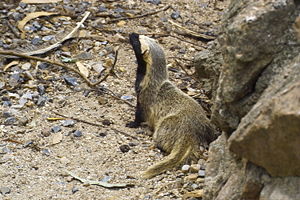Grisons
| Grisons | ||||||||||||
|---|---|---|---|---|---|---|---|---|---|---|---|---|

Little Rison ( Galictis cuja ) |
||||||||||||
| Systematics | ||||||||||||
|
||||||||||||
| Scientific name | ||||||||||||
| Galictis | ||||||||||||
| Bell , 1826 |
The grisons ( Galictis ) are a genus of carnivore living in Central and South America from the family of marten (Mustelidae), where they are counted to the subfamily Ictonychinae . There are two kinds:
- Large grison ( Galictis vittata ) and
- Little Rison ( Galictis cuja )
The Patagonian weasel ( Lyncodon patagonicus ) is also known as dwarf grison , but forms its own genus.
features
Grisons stand out due to their high-contrast coloring. The face, chest, belly and legs are colored black, the back and sides including the short tail are gray in the large grison and yellowish-gray in the small grison. In between, a white stripe runs from the forehead to the shoulders in both species. Like most martens, they are characterized by an elongated body with short legs, but the small rison looks a bit stockier. Großgrisons reach a head torso length of 48 to 55 centimeters and a weight of 1.4 to 3.3 kilograms; Small risons can reach a length of 28 to 51 centimeters and a weight of 1.0 to 2.5 kilograms. The tail is around 15 centimeters long in both species.
distribution and habitat
Grisons live in Central and South America. While large grison is widespread from Mexico to southeastern Brazil , small grison only live in central and southern South America (from southern Peru to Argentina ). Both species are not fussy about their habitat, they inhabit rainforests as well as other forest types and open terrain such as grasslands. Small risons in particular can also be found in mountainous regions.
Way of life
Grisons can be active both during the day and at night, but they are mostly found at dusk. They retreat to rest under tree roots, in crevices, hollow tree trunks or abandoned burrows of other animals (for example Viscachas ). They may also create their own huts. Their movements are nimble, they can be found both on the ground and in trees, they can climb and swim well. Their way of life roughly corresponds to that of the polecats . Although they usually hunt alone, they are often found in pairs or in small family groups.
Grisons are omnivores, but they mainly feed on small mammals. Their prey includes mice , agoutis , chinchillas and viscachas . In addition, they also eat birds and their eggs, reptiles, invertebrates and fruits.
The gestation period lasts around 40 days, and the litter size is two to four young.
Grisons and people
In South America, Grisons are tamed in some places and trained to hunt rodents, similar to European ferrets . Both species are relatively widespread and not threatened.
literature
- Ronald M. Nowak: Walker's Mammals of the World . 6th edition. Johns Hopkins University Press, Baltimore 1999, ISBN 0-8018-5789-9 (English).